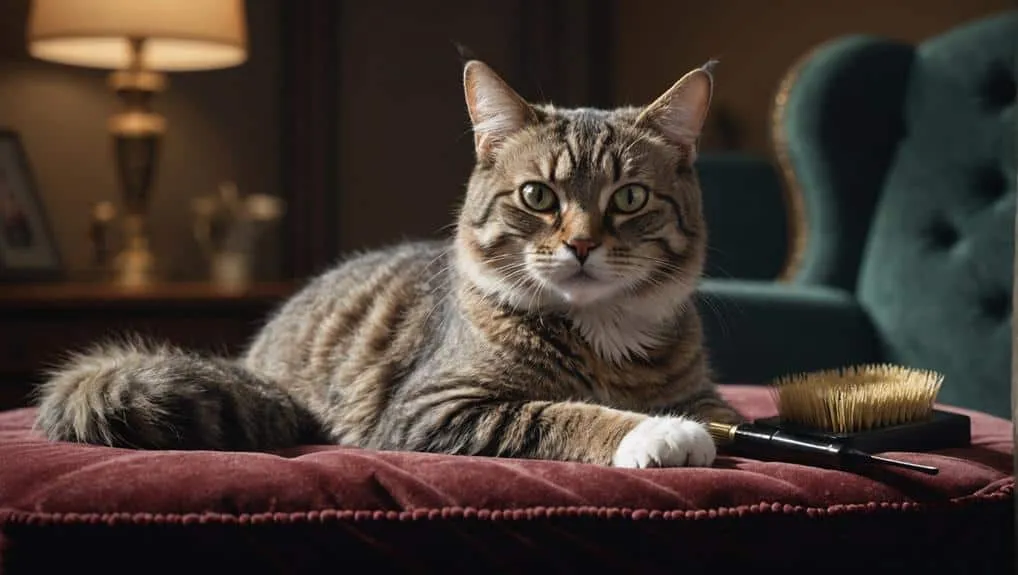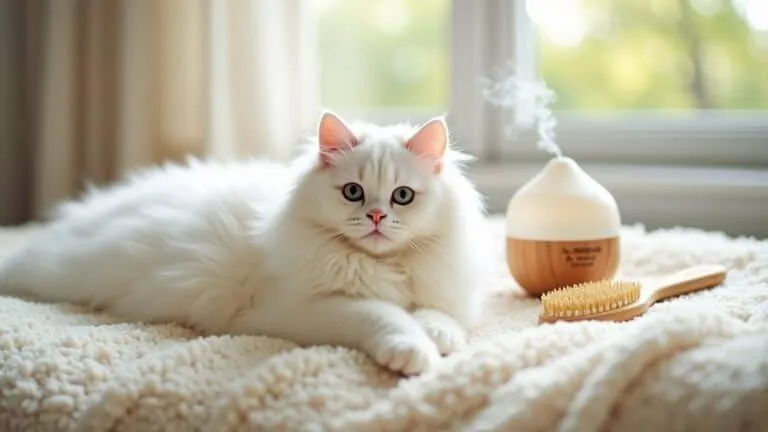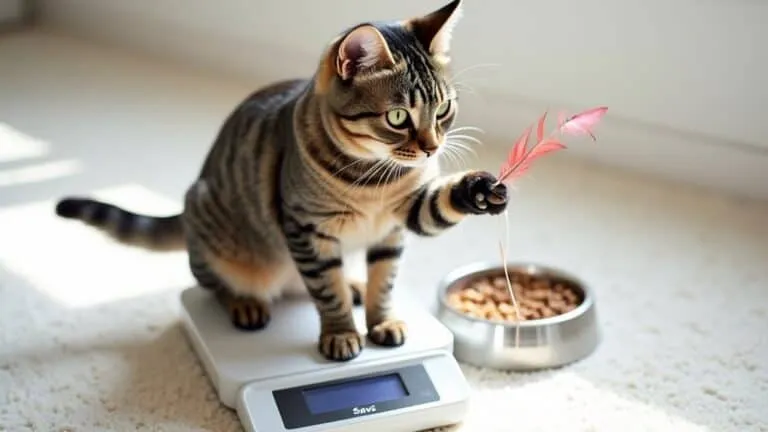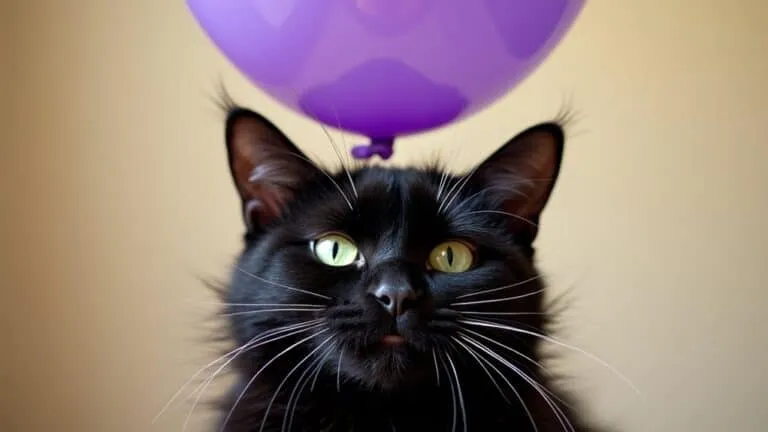The Best Fluffy Pancakes recipe you will fall in love with. Full of tips and tricks to help you make the best pancakes.

So you're dealing with excessive cat shedding and want to know how to control it.
First, it's essential to understand that shedding is a natural process for cats. However, certain factors like stress, allergies, and nutritional deficiencies can make it worse.
Regular brushing can really help reduce shedding. It's also crucial to feed your cat a balanced diet rich in fatty acids and essential nutrients. Creating a calming environment can also go a long way in reducing shedding.
But to really get to the root of the problem, you need to identify the underlying causes of excessive shedding. This could be fleas, skin issues, or even hormonal imbalances.
Once you understand what's causing the excessive shedding, you can develop a strategy to control it. By looking at the complex factors that influence cat shedding, you'll be able to come up with a comprehensive approach to manage this common issue and improve your cat's overall health and well-being.
Understanding Cat Shedding Basics
So, you wanna know about cat shedding? Well, it's a natural process that helps your cat get rid of dead hair. Long-haired breeds like Persians and Ragdolls tend to shed more than short-haired breeds.
This process is important for your cat's skin and coat health. It's pretty common for cats to shed more during seasonal changes, especially in the spring and fall. However, if your cat is shedding excessively, it could be a sign of an underlying health issue.
So, how can you reduce your cat's shedding? Start by prioritizing their overall health. Brushing your cat regularly can help remove loose hair and distribute skin oils, which promotes a healthy skin and coat. A well-balanced diet rich in essential fatty acids, vitamins, and minerals is also crucial for maintaining a healthy coat.
Identifying Causes of Excessive Shedding
Identifying the underlying causes of excessive shedding is crucial if you want to help your cat reduce hair loss. Excessive shedding can be a sign of underlying health issues, so it's essential to get to the bottom of it.
One common cause of excessive shedding is stress and anxiety. If your cat is feeling stressed, it can lead to excessive shedding. So, try to create a calming atmosphere and reduce environmental tensions. For example, you can provide a quiet space for your cat to relax, or try pheromone therapy to calm them down.
Another important factor is diet. A balanced diet rich in essential fatty acids, vitamins, and minerals is vital for maintaining a healthy coat. If your cat's diet is lacking, it can lead to excessive shedding. Make sure you're feeding your cat high-quality food that meets their nutritional needs.
Allergies can also cause skin irritation and excessive shedding. Whether it's an environmental allergy or a food allergy, it's essential to get veterinary attention to manage the issue properly. Your vet can help you identify the allergen and develop a plan to reduce your cat's symptoms.
Fleas are another common cause of excessive shedding. Flea infestations can lead to significant irritation, inflammation, and excessive grooming. That's why regular flea checks are crucial. Keep an eye out for signs of fleas, such as scratching, biting, or hair loss, and take action quickly if you suspect an infestation.
Finally, as your cat ages, they may shed more due to an inability to groom themselves effectively. Regular grooming and health assessments can help identify any issues early on and prevent excessive shedding.
Effective Grooming Techniques and Tools
Regular grooming sessions can make a big difference in reducing your cat's shedding. By using the right tools and techniques for your cat's specific fur type, you can remove loose fur and strengthen your bond with your cat, making grooming a positive experience for both of you.
When it comes to choosing grooming tools, your cat's coat type is key. Deshedding tools like rake-type brushes are great for removing loose hair, especially compared to standard brushes. If you have a long-haired breed, slicker brushes are the way to go. For short-haired cats, bristle brushes are a better fit.
Brushing your cat regularly, especially during peak shedding seasons, can really pay off in reducing shedding. Try to brush your cat daily during these times to see a noticeable difference.
Nutrition and Diet Impact on Shedding
So you're trying to get a handle on your cat's shedding, right?
Well, let's start with the basics: nutrition. What your cat eats has a big impact on their coat health, and a healthy coat is key to reducing shedding.
When your cat's diet is lacking in certain nutrients, it can make shedding worse. But on the flip side, a well-balanced diet can really help alleviate shedding issues.
Nutrition's Role
Nutrition plays a huge role in your cat's coat health. A well-balanced diet is the foundation of a healthy coat, and making informed nutritional choices can greatly impact the amount of shedding your cat experiences.
So, what can you do? For starters, feed your cat food rich in essential fatty acids, particularly omega-3s. These healthy fats support healthy skin and coat, which in turn helps reduce shedding.
It's also crucial to keep your cat hydrated. Provide fresh water at all times, and consider a balanced mix of wet and dry food to prevent dry skin. Dry skin can lead to more shedding, so it's essential to keep your cat's skin healthy and moisturized.
Dietary Deficiencies
One key reason your cat might be shedding excessively is that their diet is lacking essential nutrients. This can lead to a dull coat, dry skin, and eventually, more hair loss. As a cat owner, it's crucial that you ensure your cat is getting a high-quality diet that meets their specific nutritional needs.
If your cat's diet is missing certain nutrients, it can have a significant impact on their shedding. For example, if they're not getting enough essential fatty acids, their coat will be dull, their skin will be dry, and they'll shed more. Similarly, if they're not getting enough vitamins A, E, or B-complex, their skin health will suffer, and they'll shed more.
Dehydration can also exacerbate shedding. If your cat isn't drinking enough water, their skin will be dry, and they'll shed more. Additionally, if their diet is low in protein, their coat health will be weak, and they'll shed more. And if they're eating a poor-quality diet in general, they'll shed more and have a dull coat.
On the other hand, a diet rich in essential fatty acids, vitamins, and high-quality protein can make a big difference in reducing shedding. It's a good idea to have regular check-ins with your veterinarian to identify any specific dietary deficiencies and make adjustments to address your cat's shedding.
Monitoring Health and Addressing Issues
Monitoring your cat's health is crucial when trying to control their shedding. Regular health check-ups are a must, as they help you identify any underlying issues early on.
Skin problems, in particular, can cause excessive shedding. So, it's essential to keep an eye out for any skin issues and address them promptly.
Health Check-Ups
Regular veterinary check-ups are super important for controlling cat shedding. They can detect underlying health issues that might be causing excessive hair loss. As a responsible cat owner, you should make sure your cat gets an annual health screening. If your cat is older or at risk, they might need to go more often.
During these check-ups, your vet can keep an eye on your cat's overall health, including their coat condition. They can identify potential issues that might be causing excessive shedding.
Some key things to keep an eye out for during these visits include changes in grooming behavior or coat condition. Also, watch out for sudden increases in shedding. Scratching or skin irritation could indicate skin infections or infestations like fleas.
Identifying Skin Issues
Monitoring your cat's skin and behavior can help you identify potential skin issues that might be causing excessive shedding.
Take a close look at your cat's skin regularly to check for signs of irritation, like redness or uneven patches. These could be indicators of underlying health issues.
Also, pay attention to any changes in your cat's grooming behavior. If they're licking or grooming themselves excessively, it could be a sign of skin allergies or discomfort that's leading to increased shedding.
Keep an eye out for symptoms like flakiness, dryness, or odors, which could suggest skin infections or parasites. You'll want to get your cat to the vet if you notice these issues.
Hair loss patterns, like bald spots, can also be a sign of stress, hormonal imbalances, or medical conditions like hyperthyroidism.
It's a good idea to keep a log of your cat's shedding patterns and behaviors. This can help you identify potential health issues and give you valuable information to share with your vet.
Addressing Underlying Causes
To tackle the root causes of excessive shedding, you'll want to take a proactive approach. This means staying on top of your cat's health through regular veterinary check-ups, keeping an eye on their grooming habits, and watching for changes in their coat quality. By doing so, you'll be better equipped to identify any underlying health issues that might be contributing to the shedding.
So, what areas should you focus on?
For starters, make sure to regularly inspect your cat for parasites like fleas and ticks, which can cause skin irritation and lead to more shedding.
Another key factor is your cat's stress and anxiety levels. You can help mitigate these by creating a calm and enriching environment. This will go a long way in supporting your cat's overall coat health.
Lastly, it's essential to identify any nutritional deficiencies that might be affecting your cat's coat quality. Work closely with your veterinarian to determine if your cat's diet is lacking in any essential nutrients, and make adjustments as needed.
Home Cleaning and Maintenance Strategies
During peak shedding seasons, it's really helpful to get into some daily cleaning habits to reduce the amount of loose fur floating around your home. If you make vacuuming a priority, you can get rid of loose fur and minimize allergens. Try to vacuum at least twice a week, especially in areas where your cat spends most of its time – like the couch or your favorite armchair.
When you're not vacuuming, use high-quality lint rollers and pet-specific cleaning tools to quickly remove fur from furniture and clothing. This makes it way easier to keep your environment clean and stops fur from building up.
Here's a breakdown of some cleaning strategies you can use, how often to use them, and the benefits they bring:
| Cleaning Strategy | Frequency | Benefits |
|---|---|---|
| Vacuuming | Twice a week | Removes loose fur, minimizes allergens |
| Lint Rollers | As needed | Quickly removes fur from furniture, clothing |
| Pet-Specific Tools | As needed | Effective for removing fur from specific areas |
| Surface Protection | Ongoing | Protects surfaces from fur buildup, simplifies cleaning |
| Pet-Free Zones | Ongoing | Contains shedding to specific areas, eases cleaning |
Pest and Infestation Control Measures
Regularly inspecting your cat's coat is crucial for catching fleas, ticks, and mites early on. These pesky critters can make your cat's shedding worse and cause skin irritation if you don't take care of the problem. If you don't address it, it can lead to more serious health issues for your cat.
To prevent these infestations, you need a solid plan in place. Start by using a combination of topical treatments, oral meds, or natural repellents to reduce the chances of an infestation happening in the first place.
Keep your home clean by vacuuming often and washing your cat's bedding regularly. This will help eliminate any pests and their eggs, which in turn will reduce their impact on your cat's coat.
It's also a good idea to talk to your vet about the best pest control options for your cat. They can help you come up with a customized plan based on your cat's lifestyle and the risks they face.
Importance of Regular Veterinary Check-Ups
Regular veterinary check-ups are crucial for your cat's health and can help reduce excessive shedding. For cats of all ages, annual visits are a must to monitor their health, and seniors need more frequent check-ups due to age-related concerns.
During these visits, your vet will assess your cat's coat condition and provide personalized advice on diet and grooming to help mitigate shedding. Regular check-ups also ensure your cat receives timely vaccinations and preventive care, which contribute to their overall health and reduce shedding-related problems.
By maintaining a routine schedule of veterinary visits, you'll develop a strong relationship with your vet, allowing for personalized shedding management strategies. This, in turn, enhances your cat's quality of life and well-being.
Additional Tips for Shedding Management
Beyond veterinary check-ups, you can take several proactive steps to manage your cat's shedding. One of the most effective ways to do this is by using deshedding tools and making dietary adjustments.
First, let's talk about deshedding tools. Using high-quality cat brushes designed to reduce shedding by up to 90% can make a huge difference. Regular grooming with these brushes can improve your cat's coat health and reduce loose fur.
It's also important to establish a regular grooming schedule, including brushing at least once a week, to prevent matting and reduce shedding.
Diet also plays a significant role in managing shedding. Feeding your cat a diet rich in omega-3 fatty acids, such as fish oil, can help improve their coat health and reduce shedding.
In addition to these strategies, maintaining a consistent humidity level in your home and regular vacuuming can also help reduce shedding.
Frequently Asked Questions
What Can I Give My Cat to Reduce Shedding?
So you're wondering what you can do to reduce your cat's shedding. One thing you can try is giving your cat omega-3 rich dietary supplements, like fish oil. This can help promote healthier fur and reduce shedding.
In addition to that, regular grooming is key. Using grooming tools on your cat can really help with fur maintenance and reduce the amount of loose hair. Plus, it's a great way to bond with your cat!
It's also important to consider that sometimes shedding can be caused by anxiety or stress. So, if you think that might be the case with your cat, you could try some stress reduction techniques to help alleviate that. This can go a long way in reducing shedding.
Why Is My Cat Shedding so Much?
So, you're wondering why your cat's shedding so much? There are a few reasons why this might be happening.
First, it could just be a seasonal thing. Cats tend to shed more during certain times of the year as the weather changes. Some breeds also shed more than others, just because of their natural coat type.
But sometimes, excessive shedding can be a sign of an underlying health issue. For example, your cat might have allergies or a hormonal imbalance that's causing them to shed more. These issues can be influenced by things in their environment, like the food they eat or the air they breathe.
It's also possible that your cat's shedding is just because they need a better grooming routine. If you're not brushing them regularly, their coat can get matted and tangled, leading to more shedding.
How to Stop Cat Hair From Getting Everywhere?
So, you want to know how to stop cat hair from getting everywhere? Well, it's all about mastering some simple grooming techniques, investing in the right vacuum tools and pet-friendly products, and making lint rollers a part of your daily routine – especially during those times of the year when your cat sheds more.
What Months Do Cats Shed the Most?
So, you're wondering when your cat sheds the most? Well, it's actually during spring and fall. That's because your cat is switching between seasonal coat types, and it's all influenced by things like the temperature and daylight outside.
But here's the thing – if you have an indoor cat, they'll be shedding all year round. That's because the conditions inside your home are pretty stable, so their coat doesn't really change with the seasons.
Final Thoughts
You now have a solid grasp of cat shedding control. Identifying and addressing underlying causes is a big part of this. So is implementing effective grooming techniques and making informed nutritional choices. By doing these things, you can really cut down on shedding.
Regular veterinary check-ups are also crucial. They can help you stay on top of any health issues that might be contributing to shedding.
And don't forget about home cleaning and pest control measures. These can make a big difference too.
Staying vigilant and proactive is key to managing your cat's shedding. By following these strategies, you'll be well on your way to a cleaner, healthier home for you and your feline friend.








